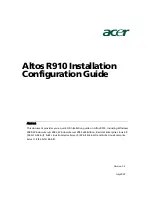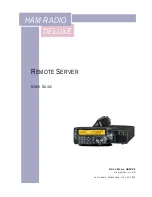
Serial Line Internet Protocol (SLIP)
5-2
893-826-A
The difference between these commands only matters in applications where the
port will initiate communication over the link. For situations where the port
initiates activity on the SLIP link, you must specify whether or not the port can
initiate communications with a remote device using CSLIP packets (using the
DEFINE/SET PORT INTERNET CSLIP ENABLED/DISABLED command).
When the use of compressed SLIP is enabled, the port will immediately begin
transmitting compressed packets on the serial link.
When compression is in use, a number of sessions (or slots) using higher-level
protocols, such as TCP/IP, can operate across a CSLIP link. This operation can
happen, for example, when the link is used in a gateway configuration that
supports several users, or in a configuration where a single node (such as a
dial-in PC) is connected to the port and the single node has several windows in
use. RFC 1144 allows a CSLIP link to use a maximum of 16 slots. (This
maximum is because the compression mechanism is very memory intensive. If
too many slots use compression, the server or the remote device could run out
of memory resources to perform other tasks.) When compression is in use on a
link, the server will allocate sufficient memory to support 16 slots (the
maximum permitted), regardless of the number of slots that will actually be
used on the link. If the remote device only supports fewer slots, that number
will be the actual number of slots used on the link.
You can examine the Enabled Characteristics field on the SHOW/LIST/
MONITOR PORT CHARACTERISTICS display to determine if the port can
initiate activity on the SLIP link using compressed SLIP packets. If it is
enabled, CSLIP will be listed.
Examples:
TS3395>> define port 6-12 internet slip enabled
TS3395>> define port 6-12 internet cslip enabled
TS3395>> set port internet slip enabled
NOTE:
In situations where the remote device initiates activity on the link, the
port automatically detects whether or not the remote device is using
compressed SLIP packets. The port uses the same type (compressed or
uncompressed) of packets as the remote device.
NOTE:
If you use a SET command at your port to enable SLIP/CSLIP,
processing begins immediately and you will not see the TS3395> command
prompt until the port is logged out and logged on again.
Содержание 3395A
Страница 8: ...viii 893 826 A ...
Страница 10: ...x 893 826 A ...
Страница 14: ...Preface Preface xiv 893 826 A ...
Страница 34: ...Introducing the Communication Server 1 20 893 826 A ...
Страница 58: ...Setting Up Basic Modem Applications 3 14 893 826 A ...
Страница 84: ...Serial Line Internet Protocol SLIP 5 8 893 826 A ...
Страница 98: ...Setting Up ARAP 6 14 893 826 A ...
Страница 112: ...Model 3395A Server Support for the Xremote Protocol 7 14 893 826 A ...
Страница 130: ...Using CCL Scripts 8 18 893 826 A matchread 20 LABEL 65 exit 0 Add Model 3395 extensions immediately after this line ...
















































